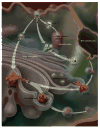Copper trafficking to the secretory pathway
- PMID: 27603756
- PMCID: PMC5548098
- DOI: 10.1039/c6mt00176a
Copper trafficking to the secretory pathway
Abstract
Copper (Cu) is indispensible for growth and development of human organisms. It is required for such fundamental and ubiquitous processes as respiration and protection against reactive oxygen species. Cu also enables catalytic activity of enzymes that critically contribute to the functional identity of many cells and tissues. Pigmentation, production of norepinephrine by the adrenal gland, the key steps in the formation of connective tissue, neuroendocrine signaling, wound healing - all these processes require Cu and depend on Cu entering the secretory pathway. To reach the Cu-dependent enzymes in a lumen of the trans-Golgi network and various vesicular compartments, Cu undertakes a complex journey crossing the extracellular and intracellular membranes and staying firmly on course while traveling in a cytosol. The proteins that assist Cu in this journey by mediating its entry, distribution, and export, have been identified. The accumulating data also indicate that the current model of cellular Cu homeostasis is still a "skeleton" that has to be fleshed out with many new details. This review summarizes recent data on the mechanisms responsible for Cu transfer to the secretory pathway. The emerging new concepts and gaps in our knowledge are discussed.
Figures



References
-
- Lee J, Pena MM, Nose Y, Thiele DJ. Biochemical characterization of the human copper transporter Ctr1. J Biol Chem. 2002;277:4380–4387. - PubMed
-
- Nose Y, Kim BE, Thiele DJ. Ctr1 drives intestinal copper absorption and is essential for growth, iron metabolism, and neonatal cardiac function. Cell Metab. 2006;4:235–244. - PubMed
Publication types
MeSH terms
Substances
Grants and funding
LinkOut - more resources
Full Text Sources
Other Literature Sources

